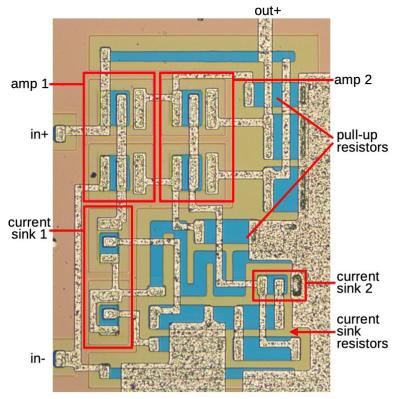It’s no secret that the work of [Ken Shirriff] graces the front pages of Hackaday quite frequently. He’s back again, this time reverse engineering a comparator chip from a photo on Twitter. The mysterious chip was decapped, photographed under a microscope, and subsequently posted on the internet with an open call to figure out what it did.
 [Ken] stepped up, and at first glance, it was obvious that most of the chip is unused, and there appeared to be four copies of the same circuit. After identifying resistors and the different transistor types, [Ken] found differential pairs.
[Ken] stepped up, and at first glance, it was obvious that most of the chip is unused, and there appeared to be four copies of the same circuit. After identifying resistors and the different transistor types, [Ken] found differential pairs.
Differential pairs form the heart of most op-amps, and by chaining them together, you can get a strong enough signal to treat it as a logic signal. Based on the design and materials, [Ken] estimates the chip is from the 1970s. Given that it appears to be ECL (Emitter-Coupled Logic), it could just be four comparators. But there are still a few things that don’t add up as two comparators have additional inverted outputs. Searching the part number offered few if any clues, so this will remain somewhat a mystery.
We’ve covered [Ken’s] incredible chip sleuthing before here, such as the Sharp EL-8 from 1969.
















Sherriff? Just how much lower can HaD get? There’s no limit, is there?
What’s wrong with Ken Sherriff?
It’s not Sherriff, it’s Shirriff.
Now be careful or I’ll put that Sharharridarriar guy on your tail. You know, that RF guy that eats SMU’s for breakfast and reviews and tears down million dollar 20GHz oscilloscopes.
You mean Shahriar Shahramian?
In the general population about 10% of people have dyslexia. Among electronics enthusiasts the percentage is higher. Until you pointed it out, I could have sworn the wrong spelling was correct. I simply never decoded the second letter. My estimate is: About 25-50% of HAD readers will have this handicap. Not all will make this specific reading-mistake, but have some form of dyslexia. But a measurable percentage WILL make this mistake. So far we have confirmation from Gravis, Matthew and rewolff.
I’m dyslexic. I never knew that “Among electronics enthusiasts the percentage is higher” that’s cool!
Pardon my being a little vague here, but yeah… it’s not distributed evenly across undergraduate majors at all. No idea if it’s indicative of anything other than self-selection. Dyslexia probably doesn’t lead quite as often to becoming a history student, for instance, though that’s hardly unknown either.
What the heck are you talking about?
I think he/she is just signaling a typo, although in the worst possible way.
It was a bit subtle but also playful.
perhaps a differential line driver transceiver the complementary outputs would drive the transmission line ( serial cable, bus whatever) l and the differential inputs would be the receivers. the single level polarity outputs would be the logic level outputs.
Impressive work, and an equally impressive write up, thank you.
ECL comparators often had dual outputs…
E.g., the 10116 chips in the counter I just fixed…
Ah, which are actually classified as line receivers…
Early CRAY machines used the equal termination loads on the balanced output ECL NAND gates that made up most of the machine to keep current draw stable, regardless of logic state. That design feature allowed them to use an absurdly simple LC filtered power supply.
Another excellent investigation. I have a tray of chips somewhere that even the manufacturers don’t recognise as existing from the part number, and I only have a rumour as to what they do. When (if – I’ve not seen them for nigh on a decade…) find them, a couple will be winging his way…
I remember Seymour Cray describing the Cray I’s ECL circuitry as fully balanced: each element produced an inverted output as well as a normal one. Perhaps the mystery chip is from the Cray I?
Not likely if your premise is correct: Only two of four comparators have the inverted output.
Early Crays were made from only a couple different ECL chips, a little register file, RAMs, and a dual NAND gate with one gate having 4 inputs and the other having 5. There were no comparators that I know of. That rules out a Cray.
@rewolff – I suffer genetically from both a form of dyslexia and a love of electronics/engineering.
(putting your name in here because threaded replies haven’t worked for me lately)
@rewolff – I suffer genetically from both some form of dyslexia and a love of electronics and engineering.
(putting your name in here because threaded replies aren’t working for me)
MECL 10104 Quad 2 input AND gate.